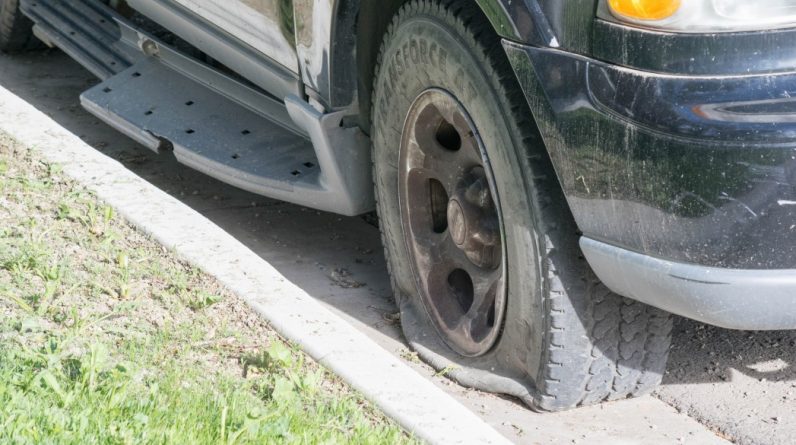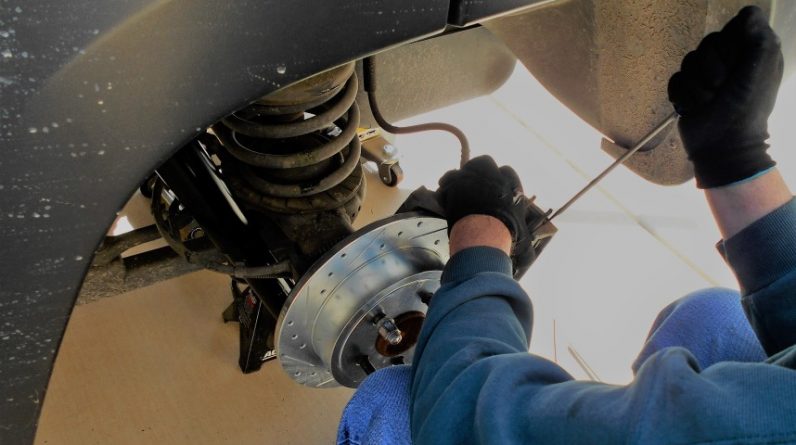
You walk outside to get into your car because its another working day. As you approach your vehicle, you realize that something is not right. You walk around to the other side and there it is. A flat tire. A feeling of dread envelops you
Or how about this scenario? You’re driving along enjoying the tunes and then all of a sudden, you feel something pulling on the steering wheel, as if one of your wheels is going through deep sand or mud. No matter how much you try to steer in the opposite direction, the vehicle pulls and pulls until you are no longer in your lane. Time to pull over.
Both scenarios above really stink! The first one is a big inconvenience. You did not anticipate having to deal with car issues this morning and now you’re going to be late for work. The second scenario is just plain scary! I’ve certainly experienced both and I’ll bet, you probably have too.
Do you know how to change a flat tire? Sure, everyone knows how to change a flat tire, right? One would think that it is simple enough and therefore common knowledge, but like common sense, that knowledge is not so common. Knowing how to change a flat tire is extremely important. I think that it should be taught to every high school student in driver’s education class and the concepts should appear on the official driver’s license test. That’s just my two cents.
Every vehicle comes from the manufacturer with a contingency plan for the inevitable flat tire event. Your vehicle has a jack and other tools such as a tire iron or wrench, a full size spare tire, a miniature or “donut” limited mile tire, or no spare or jack because it is equipped with run-flat tires. If it is equipped with run-flats, the tire inflation monitoring system will let you know if a tire has lost pressure. In this scenario, proceed as quickly as you can to a tire dealer for repair. If you do not have run-flat tires, and the chances are that you don’t, please follow the steps below.
The procedure for changing a flat tire can be broken down into the following 8 easy steps: Get to safety, Check and get equipment, Stabilize the vehicle, Jacking the vehicle, Removing the flat tire, Installing the spare tire, Lowering the vehicle, and Cleaning up the work area. Let’s take a closer look at these steps in greater detail.
Get to Safety
If your vehicle is parked at home it is probably already in a safe location for you to work. By “safe location”, I mean an area where there is limited vehicular traffic. If your tire “incident” occurred while driving, turn on your hazard lights and pull over as far as possible on the road’s shoulder. Make sure that you are not too close to a ditch or a “soft” shoulder. The area should be firm enough to support a raised vehicle on a jack.
Just a quick diversion about your flat tire. Drive as little as possible on it. As tires are not designed to be driven without air in them, the further you drive on it, the greater the chances are that you will ruin the tire and it will need replacing.
Check and get equipment
Note: Check your equipment and spare tire now, before you need them.
Examine your tire changing equipment. Find the location of your jack, spare tire, and tools. These things will more than likely be found in your trunk, underneath the floorboard. If you do not find them there, consult your owner’s manual for the location. The jack may be underneath a seat, the wrench may be under the hood, or the jack may have its own compartment somewhere inside the vehicle.
Sometimes the parts are scattered throughout. As an example, my 1997 Ford Expedition has the jack and wrench in their own compartment inside at the rear of the passenger area, the spare tire lowering iron is under the hood above the radiator, and the spare tire is on the outside, underneath the rear, just before the bumper.
Remove any items needed to gain access to these components. Check the spare tire for proper inflation and locate all jacking tools and parts. Remove them all from the vehicle. For trucks and SUVs, you will probably have to use the crank and cable mechanism accessed through a hole in the rear bumper to lower the spare tire.
Another note on safety. If you have road flares, and you should, deploy one road flare about a 100 ft from the back of your vehicle and another one at 200 ft if you are located on the side of the highway or road. This will let other drivers know that your vehicle is disabled.
Stabilize the vehicle
The next step is to stabilize your vehicle. The purpose of this is to prevent the vehicle from moving while it is being jacked. Most modern vehicles come with a wheel chock that should be placed underneath opposing front or rear wheel. The wheel chock is basically a wedge. If you do not have a wheel chock, find a large stone or piece of wood to wedge under the wheel.
Jacking vehicle
Just before jacking the vehicle, use your tire iron or crowbar to slightly loosen the wheels lug nuts or bolts. You need to do this now because once the tire is off the ground it may be impossible to loosen them because the wheel will spin when you try to do so. Be sure to consult your owner’s manual for proper jack usage.
Place the jack underneath a frame rail or at the designated jacking point. Jacking points are typically indicated by indentions underneath the doors. They may have rubber supports or holes where you can insert the jack’s hook if it has one. Place the jack foot on solid ground for support. Turn or crank the jack’s handle to raise the vehicle. Raise the vehicle high enough to not only remove the wheel with the flat tire but also high enough for the installation the fully inflated spare. Do not raise it any higher.
Removing flat tire
Hold the wheel with one hand while loosening the lug nuts with the wrench or crowbar in the other. You will have 4 or 5 lug nuts to remove. Place the lug nuts in a safe place. Most lug nuts are actually nuts that screw onto the wheel hub bolts. Other lug nuts are actually lug bolts that screw into holes in the wheel hub. The former are much easier to use while installing the spare.
Installing spare tire
Lift the spare tire up and install it on the wheel lugs. If your lug nuts are actually lug bolts, you’ll need to support the wheel to line up the hole in the wheel hub to insert the first bolt. This can be a little tricky. Make sure you don’t cross-thread the bolts. If the bolt begins to screw in but then becomes hard to turn, you’re probably cross-threading. If so, back the bolt out and start again. Start each lug or bolt but don’t completely tighten any.
You need to tighten the bolts in a “star” pattern. To do this, start all 4 or 5 bolts by hand-tightening them. Now, using your lug wrench or crowbar, tighten the bolt at 12 o’clock a little. Next, tighten the bolt at either 6 or 7 o’clock a little, depending on how many nuts/bolts you have. Then tighten the nut/bolt at 3 o’clock, then 9 o’clock, and on an on making a star pattern, tightening each lug/bolt a little more, working your way around the clock until all the nuts/bolts are fully tightened.
The purpose of this is to make sure the wheel sits evenly on the wheel hub so that it turns smoothly with no vibration or wobble. This is very important.
Lowering the vehicle
Once the spare tire is properly installed, use the jack to slowly lower the vehicle back on the ground. Make sure that there is nothing underneath the raised wheel, particularly body parts.
Cleaning up the work area
Now that you’ve changed the flat tire, its time to pick up everything. Place the wheel with the flat tire back in the trunk or wherever you removed the spare from. For trucks and SUVs, attach the tire to the cable mechanism and crank it to raise it underneath the vehicle.
Gather your jack, cranking arms, lug wrench, wheel chock, and any other parts and properly stow them. If you deployed road flares, put them out if they are still burning.
That’s it! You’re done. Proceed to the nearest mechanic or tire retailer so that they can fix or replace the flat tire. Do this as soon as possible because you don’t have another spare in case of another flat tire. Again, check your spare tire and jacking equipment now to make sure that everything is ready for that inevitable flat tire event.
Having the knowledge of how to change a flat tire will quickly get you out of potentially dangerous situations. Situations like dangerous highways or even more dangerous neighborhoods. Nobody likes to be vulnerable and the quicker you can get back into your vehicle and on your way, the better off you will be. You may even make it to work on time!






